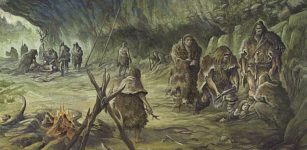Adad ‘Lord Of Abundance’- Mesopotamian Weather God Who Was Responsible For Fertility, Wealth And Oracles
A. Sutherland - AncientPages.com - In Mesopotamian (Babylonian-Akkadian) beliefs, Adad was a god of atmospheric phenomena. He mastered and controlled rains and floods, thunder, lightning, and storms.
His West Semitic name was Hadad, and in Sumer, he was known as Ishkur, associated with both the life-giving and destructive property of rain and floods. The destructive properties of the god of the storm are visible especially in worship in the southern part of Mesopotamia, and in the north, he sent beneficial rain for people’s crops.
Left: Stela (carved monument) with reliefs displaying Baal (Hadad) with lightning, 15th to 13th BC. Found in the acropolis of Ras Shamra (ancient Ugarit) source Right: Assyrian soldiers of Ashurbanipal carrying a statue of Adad (Ramman - the 'thunderer'), the god of tempest and thunder. source.
He was considered a good giver but sometimes demonstrated his destructive powers. He could guarantee rain, annual spills, good crops, and wealth. The vegetation of plants (and thus of fertility and wealth) depended on him on this mighty god.
It happened that people behaved badly, so Adad was instructed by Enlil to withhold his beneficial rain and cause drought on Earth. However, the trickster Enki, the god of water, crafts, intelligence, and creation), who had many disagreements with his brother Enlil, wanted to do against his will.
He did not want to punish humanity, and he taught humans to sacrifice directly to Adad, who - as ancient records say - was feeling very flattered and secretly moistened, the soil of the Earth so the harvests could survive.
Highly regarded with great respect, Adad (Ishkur) was worshipped circa 1900 BC or earlier to 200 BC, in Sumerian cities of Adab and Lagash, Babylonia, and Assyria, and as far west as Syria. He had important centers of worship in Babylon, Borsippa, and Ashur, the capital and ancient religious center of Assyria, and many other settlements.
In Babylonia, Assyria, and Aleppo in Syria, Adad (‘Lord of Foresight’) was linked to oracles and divination. He shared the privilege of revealing the future, together with Shamash, the sun god who was venerated by the Akkadians.
First Records Of Adad Goes Back to 3,000 BC
The first records of his divine name 'ADAD' originate from Ur III Dynasty with kings like Ur-Nammu, Shulgi, Amar-Sin ('immortal moon-god'), Shu-Sin, and others.
 Left: An Assyrian governor standing before the deities Adad (center) and Ishtar (left), limestone relief from Babylon, 8th century BC; (Museum of Oriental Antiquities, Istanbul. Weidenfeld & Nicolson Ltd.) via Britannica
Left: An Assyrian governor standing before the deities Adad (center) and Ishtar (left), limestone relief from Babylon, 8th century BC; (Museum of Oriental Antiquities, Istanbul. Weidenfeld & Nicolson Ltd.) via Britannica
It is believed that his name 'Adad' first appeared at the end of the 3rd millennium BC and was associated with the Amorites, a Semitic people from western Mesopotamia (modern-day Syria).
Adad was portrayed as a youthful god with bull horns, a bunch of lightning in one hand, and a zigzag of thunder in the other.
The bull (unicorn), sacred animal to the god Adad, in the low-relief on the Ishtar Gate at the Pergamon Museum in Berlin. Image credit: Josep Renalias - CC BY-SA 3.0
As Sumerian god Ishkur, his identification links to the destructive forces of nature meant that he was portrayed in a warlike pose, standing directly on the bull, also with lightning in his hands.
Some other depictions show him wearing a bull-horned helmet and holding a thunderbolt and trident, an attribute of Poseidon and his Roman equivalent, Neptune.
The matching symbol of this god was a sacred bull (and in some cases, also a lion) and the cypress. Adad was also sometimes depicted as a fighting leader who rushed through the clouds on his war chariot.
Adad's father was Anu, a major god of the Sumerians, Akkadians, Babylonians, and Hittite-Hurrians of Mesopotamia. However, he was also recognized as the son of Bel, 'Lord of All Lands' and god of the atmosphere. His consort was the goddess of grain, Shala (or Shalash, perhaps of a Hurrian origin).
As a Sumerian deity, Ishkur was sometimes identified with Ninurta/Ningirsu and Zababa ("the warlike Lord Kish"). Each of them personified the power of nature (thunder, storms, rains) as well as was a keeper of breeding, hunting or agriculture, and good luck in battle.
Written by – A. Sutherland - AncientPages.com Senior Staff Writer
Updated on March 27, 2024
Copyright © AncientPages.com All rights reserved. This material may not be published, broadcast, rewritten or redistributed in whole or part without the express written permission of AncientPages.com
Expand for referencesAlberto Ravinell, Whitney Green, The Storm-god in the Ancient Near East
Kriwaczek, P. Babylon: Mesopotamia and the Birth of Civilization
Leeming, D. The Oxford Companion to World Mythology
More From Ancient Pages
-
 3,800-Year-Old Cuneiform Clay Tablet With Agreement To Purchase A City Discovered In An Ancient Tumulus In Turkey
Archaeology | Aug 11, 2023
3,800-Year-Old Cuneiform Clay Tablet With Agreement To Purchase A City Discovered In An Ancient Tumulus In Turkey
Archaeology | Aug 11, 2023 -
 Unique Pig-Shaped Figurine Found In East China Was Probably A Child’s Toy 6,000-Years Ago
Archaeology | Jun 9, 2023
Unique Pig-Shaped Figurine Found In East China Was Probably A Child’s Toy 6,000-Years Ago
Archaeology | Jun 9, 2023 -
 4,000 Years Ago Women Of El Argar Used Their Teeth As Tools
Archaeology | Nov 10, 2020
4,000 Years Ago Women Of El Argar Used Their Teeth As Tools
Archaeology | Nov 10, 2020 -
 Ancient Shrine Of God Osiris-Ptah Neb And Rare Bust Of Emperor Marcus Aurelius Discovered In Egypt
Archaeology | Apr 28, 2018
Ancient Shrine Of God Osiris-Ptah Neb And Rare Bust Of Emperor Marcus Aurelius Discovered In Egypt
Archaeology | Apr 28, 2018 -
 14th Century Murals With ‘Warrior Saints’ Found In Church Of Ancient City Cherven In Bulgaria
Archaeology | Apr 10, 2020
14th Century Murals With ‘Warrior Saints’ Found In Church Of Ancient City Cherven In Bulgaria
Archaeology | Apr 10, 2020 -
 First Peoples Of Japan: Ainu Civilization And Its Unknown Origin
Ancient Mysteries | Oct 18, 2014
First Peoples Of Japan: Ainu Civilization And Its Unknown Origin
Ancient Mysteries | Oct 18, 2014 -
 Why Human Languages Can Be Likened To Branches On A Tree And Help Finding A Single Common Ancestor
Linguistic Discoveries | Sep 11, 2021
Why Human Languages Can Be Likened To Branches On A Tree And Help Finding A Single Common Ancestor
Linguistic Discoveries | Sep 11, 2021 -
 Magical Cap Of Invisibility Worn By Athena, Hades, Hermes, And Perseus
Featured Stories | Mar 25, 2019
Magical Cap Of Invisibility Worn By Athena, Hades, Hermes, And Perseus
Featured Stories | Mar 25, 2019 -
 Stunning Facial Reconstruction Of Saint Ludmila’s Sons Of The Czech Royal Premyslid Dynasty
Archaeology | Mar 8, 2021
Stunning Facial Reconstruction Of Saint Ludmila’s Sons Of The Czech Royal Premyslid Dynasty
Archaeology | Mar 8, 2021 -
 Mayan Underwater Tunnels With Bones Of Humans, Elephant-Like Creatures, Tigers, Bears, Tigers And Extinct Horses, Rediscovered In Yucatan
Archaeology | Jan 19, 2018
Mayan Underwater Tunnels With Bones Of Humans, Elephant-Like Creatures, Tigers, Bears, Tigers And Extinct Horses, Rediscovered In Yucatan
Archaeology | Jan 19, 2018 -
 Your Destiny Is Engraved And Stored – Guardians Of The Great Mystery – Part 2
Ancient Mysteries | Jul 11, 2018
Your Destiny Is Engraved And Stored – Guardians Of The Great Mystery – Part 2
Ancient Mysteries | Jul 11, 2018 -
 1,700-Year-Old Roman Shoes And An Exceptional Glass Workshop Unearthed In France
Archaeology | Jun 5, 2023
1,700-Year-Old Roman Shoes And An Exceptional Glass Workshop Unearthed In France
Archaeology | Jun 5, 2023 -
 Did The 8 Omens Of The Aztecs Foretell The End Of Their Civilization?
Civilizations | Jan 30, 2020
Did The 8 Omens Of The Aztecs Foretell The End Of Their Civilization?
Civilizations | Jan 30, 2020 -
 Neanderthals Buried Their Dead – New Evidence
Archaeology | Dec 10, 2020
Neanderthals Buried Their Dead – New Evidence
Archaeology | Dec 10, 2020 -
 Italian Sailors Knew Of America 150 Years Before Christopher Columbus – Ancient Documents Reveal
Archaeology | Oct 8, 2021
Italian Sailors Knew Of America 150 Years Before Christopher Columbus – Ancient Documents Reveal
Archaeology | Oct 8, 2021 -
 Traces Of Ancient Near East Civilization In America – An Out-Of-Place Ancient Inscription – Part 2
Ancient Mysteries | Nov 13, 2020
Traces Of Ancient Near East Civilization In America – An Out-Of-Place Ancient Inscription – Part 2
Ancient Mysteries | Nov 13, 2020 -
 The Hitra Man Lived In A Turbulent Time – Was He A Stone Age Warrior?
Archaeology | May 10, 2024
The Hitra Man Lived In A Turbulent Time – Was He A Stone Age Warrior?
Archaeology | May 10, 2024 -
 First Bathrooms Appeared Around 8,000 B.C In Scotland
Ancient History Facts | Dec 11, 2016
First Bathrooms Appeared Around 8,000 B.C In Scotland
Ancient History Facts | Dec 11, 2016 -
 Focus On Turkana Boy: Modern Human Body Evolved More Recently Than Once Believed
Archaeology | Jul 8, 2020
Focus On Turkana Boy: Modern Human Body Evolved More Recently Than Once Believed
Archaeology | Jul 8, 2020 -
 Ancient City Of Sogmatar And Recent Discovery Of 5,000-Year-Old Children’s Toy
Archaeology | Oct 6, 2017
Ancient City Of Sogmatar And Recent Discovery Of 5,000-Year-Old Children’s Toy
Archaeology | Oct 6, 2017


